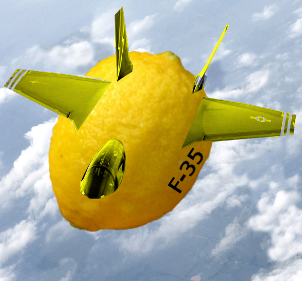Fifty-eight fighter jets could be $12 bil "dud"
 Australia will buy dozens of fighter jets at a cost of more than $12 billion, despite a raft of concerns about their design and abilities.
Australia will buy dozens of fighter jets at a cost of more than $12 billion, despite a raft of concerns about their design and abilities.
Australia has followed through on a commitment from over ten years ago, upholding its order for 58 more Lockheed Martin F-35 Lightning II planes, commonly known as Joint Strike Fighters, in addition to 12 already purchased and 2 already delivered.
The money will come from the standard operating budget of the Department of Defence.
The sale is going ahead despite the broad concerns with the design, an option not to buy the possibly faulty jets and a general government push to save money.
Prime Minister Tony Abbott says the fleet of supersonic jets will be used for surveillance duties.
“Together with the Super Hornet and Growler electronic warfare aircraft, the F-35 aircraft will ensure Australia maintains a regional air combat edge,” he said in an announcement this week.
“The F-35 will provide a major boost to the ADF's intelligence, surveillance and reconnaissance capabilities.
“The acquisition of F-35 aircraft will bring significant economic benefits to Australia, including regional areas and local defence industry.”
The economic benefits include jobs at air bases in Williamtown in New South Wales and Tindal in the Northern Territory. The jobs will be available when the facilities are actually built, at a cost of $1.6 billion.
The potential problems with the plane dubbed “the most advanced in the world” are numerous and well reported.
“We've looked at the reliability too and it is a really big concern now - it's very risky,” US General Accounting Office's Michael Sullivan told a recent hearing of the US House Armed Services Committee.
The price of the planes is expected to rise, as it has already run close to 50 per cent over budget.
“The estimate now is deemed unaffordable...that's all got as much to do with reliability of the aircraft as anything else,” Sullivan said.
“Not just in terms of getting the unit costs down on the aircraft, but also in terms of the operating and support costs.”
California Democrat Loretta Sanchez recently said the F-35 could only handle about four hours of operation between “critical failures”, and that pieces are falling off the aircraft in many tests.
Lieutenant General Bogdan acknowledged this too, saying program bosses knew parts were coming off the aircraft “too frequently” for proper maintenance.
“The problem here is you're not going to see results in the next two to three months,” he said.
“It's going to take months and months and months of constant efforts to see this improve.
“Our goal is by 2015 to see the aircraft at 60 per cent [reliability].”
In 2009, the Wall Street Journal published reports that Chinese cyber- spies had hacked the F35 design database and acquired terabytes of secret information about the fighter, greatly compromising its future effectiveness.
Defence media in the US have alleged that Major Richard Koch, chief of USAF Air Combat Command’s advanced air dominance branch, stated in 2008: “I wake up in a cold sweat at the thought of the F-35 going in with only two air-dominance weapons.”
Back in Australia, military analyst and Liberal Party MP Dr Dennis Jensen has been vocal, and blunt, about the necessity of the purchase.
“It's a dud decision,” Dr Jensen told the Sydney Morning Herald.
“The last couple of [US operational testing] reports ... have shown very, very significant problems with this aircraft.”
“We should be ensuring that this aircraft is defined as fit for purpose before we purchase it... we haven't done that.”
Defence Minister David Johnston has told the ABC that Australia has the option to not buy the planes.
“If Australia decides that the costs have blown out to such an extent, we are not bound to continue,” he said.
“[But] we are committed to the program... this aircraft is simply the best thing happening in air combat at the moment.”
Canada had been a big supporter of the program until its government received a damning report in 2012 and its involvement in the project was halted.
After considering its options for the last eighteen months, Canada will soon announce whether it will continue investing the the Joint Strike Fighter F-35 program, or pursue other plans.
Dr Jensen says for Australia, it may be too late to eject.
“Once you've made a decision like this, it takes more balls to actually say the emperor's got no clothes than to continue pretending that the emperor in fact has clothes.
“I wouldn't be critical of the Defence Minister only... it shows a lack of judgment on so many levels,” he said.
Making the $12 billion announcement this week, Mr Abbott said: “The fifth-generation F-35 is the most advanced fighter in production anywhere in the world and will make a vital contribution to our national security.”
He presumably forgot to mention the more advanced F-22, which the United States refuses to sell to any other country.
Australia's first F-35 fighter jet is expected to be in service by the year 2020.








 Print
Print